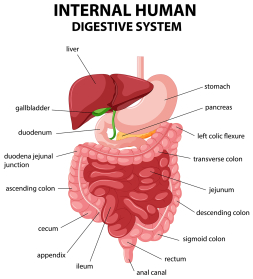Journey Through The GI Tract FINAL PART: Rectum & Anus

In this final lesson of ‘My GI Tract’ series, you will learn how the rectum and anus work together to break down the foods that we consume.
Here’s a quick recap. The digestive process begins in the mouth. It receives the food and breaks it up into small, easy-to-swallow pieces. Enzymes from the saliva break down any starch and the food passes into a long tube called the oesophagus. It carries the food bolus along its length, and contracts (peristalsis) to move food down towards the stomach. The enzymes and acids in the stomach continue the process of breaking down food, before they are released into the small intestine. The small intestine receives food from the stomach and continues to break down the food while absorbing the majority of its nutrients. In the upper section of your small intestine (duodenum), digestion continues as chyme from the stomach mixes with a variety of digestive juices from your pancreas, liver and gallbladder. At end of the journey through the small intestine, most nutrients from digested food have been absorbed. In the large intestine, undigested material, excess fluids, and mucus all combine to form stool. At the lower end of your large intestine, is the rectum, which temporarily stores stool we are ready to expel the stool through the Anus.
Rectum
The rectum has a slight S-shape, with two bends in it. It is roughly an 8-inch chamber that connects the colon to the anus. It receives stool from the colon, sends signals to the brain if there is stool to be released, and stores it until it passes out of the body through the anus. Your rectum is made up of layers of muscles and tissues, with glands on the inside that secret and absorb. When its muscles activate to move waste through, it can contract and shorten, and stretch to accommodate more waste.
The primary function of the rectum is to collect and hold stool until it’s time to release it. Your rectum relaxes and stretches to accommodate the waste as it gradually comes in from your colon. While holding it, your rectum absorbs the remaining water and electrolytes and further solidifies the waste. It secretes mucus to help it pass through smoothly. When it’s full, nerves that detect stretch in the rectal wall (stretch receptors) communicate to your central nervous system that it’s time to release. Increasing pressure will make it increasingly hard to hold it in and trigger the urge to release.
Anus
The last part of the digestive tract, the anus, is the opening at the far end of the digestive tract through which stool leaves the body. It consists of pelvic floor muscles and two anal sphincters (internal and external) that control your bowel movements.
Did you know? Your food’s long journey, typically lasting between 30 and 40 hours!
